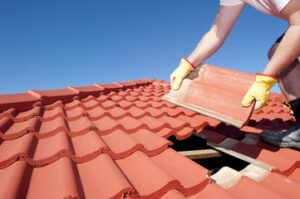A roof is a critical component of a building, providing insulation and protection from the elements. It has evolved in a wide variety of forms, depending on technical, aesthetic and cost considerations.

Roofing is labor intensive and poses some safety concerns, especially on steep roofs. Nonetheless, it can add to the resale value of a home or commercial property. Visit https://www.evansvilleroofs.com/ to learn more.
Roofing materials are the building blocks of a roof, and the type of material you choose can greatly affect the cost and appearance of your home. The materials that are available to you can range from natural woods and clay tiles to fiberglass shingles and synthetic slate. Several factors will influence which material you select: the architectural style of your home, local weather patterns, and your budget.
Wood shingles and shakes are made from naturally occurring materials and have long been a popular roofing choice, especially for Cape Cod-style homes. The natural beauty of these roofs, however, makes them expensive and less suitable for climates that experience heavy snowfall or wildfire. Synthetic slate shingles are an attractive alternative that looks like the real thing but is less costly and more durable.
Rolled or membrane roofing is a cheap, easy-to-install option for flat or low-slope roofs. It consists of a layer of flexible fabric that is sandwiched between two layers of felt or other material and coated in bitumen. The felts can be reinforced with organic or glass fiber mats, and the bitumen can be asphalt, tar, or cold-applied adhesive (which doesn’t need to be heated before application). This type of roof is not as durable as other types and may leak if not properly installed.
Metal roofing is a durable and long-lasting choice, with plenty of options to fit your style and budget. The most common materials are corrugated galvanized steel, stainless steel, aluminum, and copper. These roofs can last for decades and come in a variety of colors, thicknesses, and styles.
Adding a mineral-surfaced leak barrier to the vulnerable areas of your roof like the eaves and valleys is a good way to prevent damage from ice dams, wind-driven rain, and other common issues. Leak barriers such as GAF WeatherWatch are a great way to protect your investment and add to the longevity of your roof.
Installation
A quality roof protects a home or building from rain and snow, drains water away from the structure, and insulates to keep it warm or cool. The roofing process requires extensive knowledge and meticulous attention to detail. Whether you decide to do it yourself or hire professionals, understanding the installation process can help you get the most out of your investment.
To install a new roof, the first step is to prepare the surface. The roofing crew will find the access point, set up ladders and other tools, and cover anything that could be damaged by debris. Next, they will install the underlayment and shingle strips. The underlayment is made from sheets of felt or mat, reinforced with glass-fiber or organic material and saturated with bitumen. Bitumen can be asphalt, tar, or cold-applied adhesives.
Once the underlayment is in place, the shingles are nailed to it. The contractor will overlap the first row by at least six inches and follow a nail pattern that starts close to the edge and then spreads out. This is to prevent moisture from getting under the shingles.
Maintenance
Roofs must be maintained to ensure their integrity against the elements. This requires regular inspections and cleaning procedures. For example, accumulated dirt can clog drains, and falling tree limbs can damage roof membranes and structural elements. It is important to regularly trim overhanging tree limbs to maintain a safe distance from the roof, and to repair or replace flashing (a thin material installed to direct water away from areas where the roof plane meets a vertical surface such as a chimney or dormer) when damaged. In addition, organic growth such as moss should be removed promptly to prevent degradation of the shingles and underlying structures.
Roofing is an architectural feature that covers the top of a building to protect against rain, snow, sunlight, wind and extremes of temperature. It is usually made of layered felts or other durable materials that are impregnated with bitumen and often covered with a layer of protective granules.